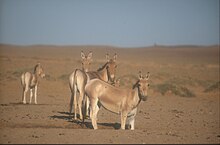Mongolian wild ass
| Mongolian wild ass | |
|---|---|

| |
| Mongolian wild asses in the Gobi Desert, Mongolia. | |
| Scientific classification | |
| Domain: | Eukaryota |
| Kingdom: | Animalia |
| Phylum: | Chordata |
| Class: | Mammalia |
| Order: | Perissodactyla |
| Family: | Equidae |
| Genus: | Equus |
| Species: | |
| Subspecies: | E. h. hemionus
|
| Trinomial name | |
| Equus hemionus hemionus Pallas, 1775
| |
| Synonyms[3] | |
| |
The Mongolian wild ass (Equus hemionus hemionus), also known as Mongolian khulan, is the
Taxonomy and etymology
The Mongolian wild ass is synonymous with the Gobi khulan (Equus hemionus luteus),[1] also called the chigetai, dziggetai or simply khulan, Mongolian: Хулан.[6]
Habitat and population

The Mongolian wild ass has become primarily confined to the desert-steppe, semi-desert and deserts habitats of Gobi Desert.
The Mongolian wild ass is the most widespread subspecies, although despite that, the subspecies lost about 50% of its former distribution range in Mongolia in the past 70 years. The former range of the Asiatic wild ass in East Asia between the seventeenth and the middle of the nineteenth century encompassed the greater part of Mongolia, areas of Siberia and
Biology and behavior
The Mongolian wild ass are herbivorous mammals. They feed on
Mongolian khulans are known to dig holes at dry river beds and water sources to access subsurface water to drink in response of the lack of water during hot summers in the Gobi Desert. Watering holes dug by khulans are also used by other species (wild and domestic) as well as by humans to access to water.[11]
Threats
The Mongolian wild ass population is declining due to poaching and competition from grazing livestock. The conservation status of the species is evaluated as endangered.[1]
The Mongolian khulan are threatened by apex predators such as
that became extinct within the regions.Poaching for meat appears to be an increasing problem in Mongolia. For some parts of the local population, wild ass and other wildlife meat seems to provide a substitute or even a cheap alternative to meat from domestic animals.[12] In 2005, a national survey based on questionnaires, suggested that as many as 4,500 wild asses, about 20% of the whole population, may be poached each year.[13] Moreover, political changes in the early 1990s allowed urban populations to return to nomadic land use, resulting in a sharp increase in human and livestock numbers in many rural areas.[14][15][16]
Political and societal changes have disrupted traditional land use patterns, weakened law enforcement and also changed attitudes towards the use of natural resources, e.g., making wildlife an "open access" resource.[17] It is expected that the re-migration of people and their livestock will result in increased wildlife–human interactions and may well threaten the survival of rare wildlife species in the Gobi Desert.
Conservation actions

Since 1953, the Mongolian wild ass has been fully protected in Mongolia. The subspecies is also listed at appendix I of CITES (the Convention on the International Trade in Endangered Species of Wild Flora and Fauna) and was added to appendix II of the Convention of Migratory Species in 2002.[18] However, due to human population growth in conjunction with severe winters in the past years,[19] the number of conflicts between herders and Mongolian wild asses appear on the increase. Information on the basic biology of the subspecies and how it differs from others is lacking, which hampers conservation efforts.[20]
In captivity
The Mongolian wild asses are rare in captivity in the world, though the captive animals are mostly found in China, such as in Beijing Zoo, Shanghai Zoo and Kunming Zoo at Yunnan.
Related subspecies
- Turkmenian kulan, Equus hemionus kulan
- Persian onager (gur), Equus hemionus onager
- Indian wild ass (khur), Equus hemionus khur
- Syrian wild ass or hemippe, Equus hemionus hemippus (extinct)
See also
- Kiang or, Tibetan wild ass
- Przewalski's horse or, Mongolian wild horse
- Mongolian horse
- Takhi
- Horses in East Asian warfare
- Yakutian horse
References
- ^ . Retrieved 11 November 2021.
- ^ "Appendices | CITES". cites.org. Retrieved 2022-01-14.
- ISBN 978-1-421-40093-8.
- ^ Clark, B. and Duncan, P. (1992). "Asian Wild Asses - Hemiones and Kiangs (E. hemionus Pallas and E. kiang Moorcroft)", pp. 17–21. In: P. Duncan (ed.) Zebras, Asses, and Horses: An Action Plan for the Conservation of Wild Equids. Gland, Switzerland: IUCN/SSC Equid Specialist Group.
- .
- ISBN 978-0851994307.
- .
- ^ Mongolian Ministry of Nature and Environment. 2003. Status and distribution of the khulan in Mongolia in 2003. Unpublished report, Mongolian Ministry of Nature and Environment, Ulaanbaatar, Mongolia
- ISBN 9780198509271.
- ^ Kaczensky P. and C. Walzer. 2002a, 2002b, 2003a, 2003b. Przewalski horses, wolves and khulans in Mongolia. Bi-annual progress reports. available from: www.takhi.org
- ^ Anne-Camille SOURIS & Association Goviin Khulan http://www.goviinkhulan.com, http://annecamille-souris.jimdo.com/work/ Archived 2013-07-23 at archive.today
- ^ P. Kaczensky & O. Gambatar unpubl. Data
- ^ J. Wingard unpubl. data
- PMID 20662187.
- .
- ^ R. Mearns; D. Shombodon; G. Narangerel; U. Tuul; A. Enkhamgalan; B. Myagmarzhav; A. Bayanjargal & B. Bekhsuren (1994). "Natural resource mapping and seasonal variations and stresses in Mongolia" (PDF). RRA Notes. 20: 95–105.[permanent dead link]
- S2CID 32182395.
- ^ CMS 2002. Convention on Migratory Species. Appendix II. Archived 2006-05-13 at the Wayback Machine
- ^ United Nations Disaster Management Team (UNDMT): National Civil Defense and State Emergency Commission Ulaanbaatar. 2000. DZUD 2000-Mongolia: An evolving ecological, social and economic disaster: A rapid needs assessment report. United Nations Disaster Management Team (UNDMT): National Civil Defense and State Emergency Commission Ulaanbaatar
- ^ "Asiatic Wild Ass Equus hemionus". IUCN.org. IUCN/SSC Equid Specialist Group. Archived from the original on 2012-12-20.

